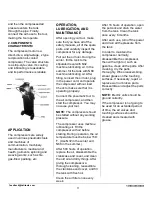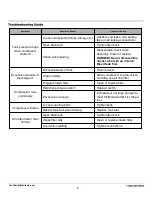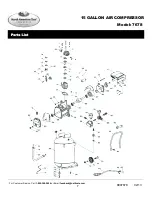
2
The solvents trichloroethane
and Methylene Chloride can
chemically react with aluminum
used in paint spray guns, paint
pumps, etc. and cause an
explosion. If you are using
these solvents, use only
stainless steel spray equipment.
This does not affect your air
compressor, but may affect the
equipment being used.
Never directly inhale
compressed air produced by a
compressor. It is not suitable for
breathing purposes.
Do not weld on the air tank of
this compressor. Welding on the
air compressor tank may
weaken the tank and result in
extremely hazardous
conditions. Welding on the tank
in any manner will void the
warranty.
Never use an electric air
compressor outdoors when it is
raining or on a wet surface, as it
may cause electric shock.
When not in use or before
servicing, make sure that the
compressor is turned off,
unplugged from the power
source, and all pressure has
been released from the unit.
Check the manufacturer’s
maximum pressure rating for air
tools and accessories. The
compressor outlet pressure
must be regulated so that it
never exceeds the maximum
pressure rating of the tool.
High temperatures and moving
parts are present under the
shroud. In order to prevent
burns or other injuries, do not
operate with the shroud
removed. Allow the compressor
parts to cool before handling or
servicing.
Be certain to read all the labels
and follow all safety instructions
when you are spraying paint or
toxic materials. If there is a
chance of inhaling anything you
are spraying, use a respirator
mask. Read all instructions and
be sure that your respirator mask
will protect you from the fumes.
Always wear safety goggles or
glasses when using an air
compressor. Never point the
nozzle or sprayer toward a
person or any part of the body.
Do not adjust the pressure switch
or relief valve for any reason.
Doing so will void the warranty.
The compressor is preset for the
maximum pressure of the unit.
Drain the moisture from the tank
on a daily basis. A clean, dry
tank will help prevent corrosion.
Pull the pressure relief valve ring
daily to ensure that the valve is
functioning properly, and to clear
the valve of any possible
obstructions.
To provide proper ventilation for
cooling, the compressor must be
kept at a minimum of a foot from
the nearest wall, in a well-
ventilated area.
Fasten the compressor down
securely. If transporting is
necessary, the pressure must be
released from the tank before
transporting.
Protect the air hose and electric
cord from damage and puncture.
Inspect them weekly for weak or
worn spots and replace, if
necessary.
WARNING
Disconnect the power and
release all pressure from the
system before attempting to
install, service, relocate, or
perform any maintenance.
Follow all electrical and safety
codes as well as National
Electrical Codes (NEC) and
Occupational Safety and Health
Act (OSHA).
Electric motors and starters must
be securely and adequately
grounded using a three-pronged
outlet.
CAUTION
Never use an extension cord with
this product. Use additional air
hose instead of an extension
cord to avoid power loss and
permanent motor damage. Use
of an extension cord will void the
warranty.
OPERATING PRINCIPLE
AND COMPONENTS
CHARACTERISTIC
1. OPERATION PRINCIPLE
The compressor is driven by the
motor directly. The crankshaft
turns to drive the connecting rod
up and down; the connecting rod
drives the piston back and forth.
The piston’s movement leads to
the air pressure in the cylinder.
The air valve in the cylinder head
makes the natural air enter into
the cylinder through the air filter,
feedback@natitools.com
Summary of Contents for 7678
Page 8: ...8 feedback natitools com ...


























